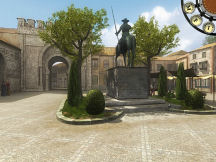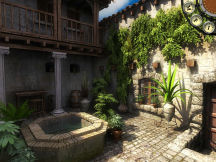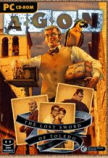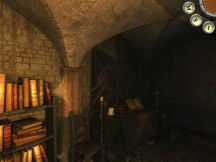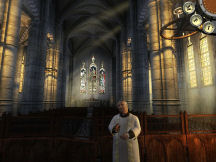“Well to tell you a little about my ‘research’. “ Samuel
Hunt
AGON: The Lost Sword of Toledo (LSoT)
is the fourth episode of a planned fourteen game series by Hungarian
developers Private Moon Studios. The series debuted in September 2003 and
introduced us to Professor Samuel Hunt, cultural historian cum detective.
The year is 1903 and Prof. Hunt is employed by the
British Museum to find a set of mystical board games as well as a
number of puzzling manuscripts. His quest begins in London and continues
on to such exotic locations as Lapland and Madagascar in parts Two and
Three. Subsequently, the first three games were bundled and released on CD
as AGON: The Mysterious Codex.
It is not necessary to have played AGON: The
Mysterious Codex before playing LSoT. It stands on its own.
However, if you want a little background, stop by Dorothy’s table (main
menu).
“A
strange fog surrounds this story.” Samuel Hunt
This brings us to The Lost Sword of Toledo,
which is a beautiful, atmospheric game told from the first person
viewpoint. It uses node to node movement and 360 degree panning.
Once again, Prof. Hunt is on the trail of a mysterious
board game and this time he journeys to the charming town of Toledo,
Spain. In the opening screen, we watch as a simple line drawing depicting
the coach and landscape are created and washed with color. Prof. Hunt
narrates a letter to his wife. We learn that the trip is going well.
However, he has a strange feeling and gratefully accepts her suggestion
that he call on her old drawing master, Salvador Diez Palencia. Perhaps
this gentleman will have information about the Candelas family for whom he
is searching.
Prof. Hunt alights in the Plaza de la Mancha, a
sun-drenched (though strangely quiet) town square. His inquiries soon
bring him to the Diez home where he learns that Salvador has passed away.
However, his daughter, Carmen, a quiet and somber woman, is pleased to
offer the hospitality of her home.
He soon learns that Carmen is in love with Francisco
Candelas (yes, the very family he seeks), a worthy and honest man who has
been jailed for theft of an heirloom sword made by his famous grandfather,
but tragically lost by his father. Worse yet, Salvador Diez has
inexplicably and uncharacteristically bequeathed all he owns to Toledo’s
most prominent citizen, Alonso Garcia de la Rica. Sadly, this includes the
hand of a very unwilling Carmen in wedlock to the detestable Eugenio, heir
of Alonso Garcia.
That affairs are in a confused state is obvious, and
Prof. Hunt undertakes to clear up the local mysteries and unite the
separated lovers as well as to complete his mission.
“It would
be a mistake to believe everything one hears.” Samuel Hunt
He’ll do this by interaction with local folks via a
standard dialogue tree. LSoT includes lots of dialogue, most of
which serves to round out the players or provide clues and direction. Once
initiated, it can’t be skipped which can, from time to time, be annoying.
In addition to obtaining clues directly from
conversations, reading often serves to move the story forward. Though not
all the available books are required to solve the game, I enjoyed perusing
them all. I appreciated the aged appearance of the books and letters
(spotted with age with faint fold lines, some areas blurred). Though I
couldn’t actually touch them, reading them made me feel as if I were
browsing the library of an old friend.
I am particularly impressed with the way written
material is presented. The flowing cursive script is beautiful to gaze at
but can be hard to read. Hovering the cursor over any paragraph produces
an easier-to-decipher copy of the text.
“We all
carry secrets which we should not make public.” Arriaga
In the course of his investigation Hunt meets many of
the local citizens. Among others, he meets Domingo, a solitary guitarist
and chats with Father Perez at the Church of San Pedro. He forms an odd
friendship with Hugo, a butler whose past is slightly shady. Though the
various people he meets are not exactly stereotypical, they are certainly
not unexpected. However, it scarcely mattered that the locals were not
novel as I grew to like them anyway.
Characters gesture or move slightly during conversations
and mouth movements are in sync with the dialogue. Their eyes shift focus
giving a certain life to them. However, though some are more “real” than
others, none are lifelike. Skin lacks authentic texture and several had a
faint black line running the length of their noses and sometimes, their
chins or foreheads. Perhaps this was a fault in my computer, perhaps not.
“If you open the lid the small
machine plays my father’s favorite tune. “ Carmen
Voice acting is a mixed bag. Some voices were very good,
others merely adequate, but none were truly terrible. I particularly
enjoyed the voices of both Isabella and Francisco Candelas but found the
prosody of Toledo’s local constable to be off. Prof. Hunt’s voice is spot
on—his soft-spoken style reminiscent of academicians to this day.
Environmental sounds are well done. I loved listening to
the birds chirping in the garden, pigeons cooing in the belfry, wind
jostling through the trees and footsteps echoing off cobblestones. If I
listened very carefully in certain spots, I heard the far-off mournful
howling of dogs.
Background music contributed greatly to the atmosphere
of the game. It varied from guitar to woodwinds, tossed in some piano and
a little percussion. Much of it was upbeat, but at times it was tense and
when appropriate, meditative. Sometimes, its absence allowed me to explore
in quiet. It always set the mood of that particular section of the game
and was seldom intrusive.
“He
taught the girls and the ladies how to paint.” Carmen
Upon arrival at the Plaza de la Mancha, I was greeted by
a town square filled with muted sandstone reds, varying shades of gray and
brown, verdant trees and Moorish arches all set against a background of a
brilliant blue sky and white clouds. This delicate palette continues
throughout the game. I did miss animations within each setting though.
Textures and detail vary. Rough stone are juxtaposed
against those worn smooth with time, and both contrast with the green
slickness of potted plants. Deep shadows lie against areas of bright sun.
Attention to detail is shown in the letters carved into the underside of a
sewer grate.
I was particularly struck
by the use of reflections. I noticed mirror-like images of non-player
characters in shop windows and even Prof. Hunt’s likeness staring back at
me from time to time. This added greatly to my immersion in the game.
Much of the game is well
lit, but there is a darker section in the sewer. However, it never slipped
into the “too dark to function” category.
Transitions are
illustrated graphic novel style, and can be skipped by the Esc key.
“Strangely, he included the music box he’d been making for months.” Carmen
LSoT’s
puzzles are a varied and enjoyable lot and most flow from the story. They
include inventory, pattern matching, logic, and one somewhat dependent on
sound. Many of the puzzles are complex and multi-stepped, but they are all
fairly (if sometimes subtly) clued. You will have to pay attention in this
game. I never pixel hunted, but did find a few areas “picky” regarding
placement of inventory items.
There is one maze, but ample clues are provided to
traverse it.
There are no mini-games, but there is a board game at
the end. Happily, the level of difficulty is adjustable and it can also be
skipped. I love that feature! I was terrible at Alquerque, which is an
actual historic board game dating back to the 1400’s, but found it fun and
have gone back and played it several times since.
There are no totally color dependent puzzles, none
requiring timed action, and you cannot die. I enjoyed all the puzzles,
even the ones I needed a nudge to complete. Several were quite clever and
one was beautiful.
“I’ll see
what I can do.” Samuel Hunt
The point-and-click interface is generally easy to use,
if not quite intuitive. I thought myself stuck almost as soon as the game
began as I forgot to hold down the left mouse button in order to pan
around. Too, there was one area where the controls were clumsy. I knew
exactly what I needed to do, but had a difficult time doing it.
LSoT features a smart
cursor and most actions are performed with the left mouse button, i.e.
walking, picking up items, etc. An arrow indicates directions of possible
movement. It is Alt+Tab friendly.
Inventory is displayed in a scrolling bar across the top
of the screen, but can be minimized. Some items need to be combined and
this is easily done. Documents and a few objects are marked with a small
gear indicating you can examine these more closely by right clicking.
“Maybe it
is still worth a try.” Samuel Hunt
LSoT includes a journal
which records most of the game’s dialogues, a feature which I found very
helpful.
It also includes a map allowing for instant travel from
location to location. I much appreciated the ability to jump from one area
to another, but do not understand why the map was not available all the
time. It can only be accessed from certain spots.
You can save at any time, a desirable feature in any
game and the game auto saves upon exit. However, you cannot name your
saves. Instead, they are marked by a two inch by three inch picture
bearing the location, date, and time. As I was in most locations numerous
times this was not optimal. Sadly, you can only save eight times.
Many of the game settings are customizable. I
particularly appreciated the ability to adjust voice, ambient sounds, and
background music independently. Panning speed is also adjustable.
“Maybe
the situation was not so bad.” Samuel Hunt
Overall, LSoT was stable on my machine. However,
on one occasion I clicked in rapid succession on several different
dialogue choices. This caused all the chosen lines to play simultaneously
which necessitated dropping back to a saved game.
“I was
simply an observant outsider ...” Samuel Hunt
AGON: The Lost Sword of Toledo
is a game for those who like to meander and ponder. It’s a game to be
savored slowly. From its opening screen to the closing credits, I was
entranced.
Grade: A-
Quick List:
1st person
viewpoint
Point and click
controls
Alt+Tab friendly
Save at will,
but can’t name saves
Saves limited to
8
Node to node
movement
360 degree
panning, but can be done very slowly
Subtitles
available
Background
material on first 3 episodes available
In-game journal
records most dialogue
Dialogue can’t
be skipped once triggered
Ambient sounds
and background music add atmosphere
Voice acting
runs the gamut from not-so-good to very well done
Graphics range
from very detailed in places to average in other places
Multi-stepped
puzzles
Inventory
puzzles
Logic based
puzzles
One maze (has
clues to navigate)
One sound
dependent puzzle
Pattern matching
puzzles
No color
dependent puzzles
No timed puzzles
No dying
I played
this game on:
OS:Win XP
Professional
Processor: Intel
Core 2 Quad CPU @ 2.40 ghz
Ram: 3.25GB Dual
Channel DDR2 667 w/ECC 2-DIMMs
Gx card: nVidia
GE Force 8800 GTS
Sound card:
Creative Labs Sound Blaster X-FI Xtreme Music
April 2008
design copyright ©
2008
GameBoomers
Group
